


Reliable information on the contribution of our industry to employment and income generation is one of the key instruments required to place the sector in the national and global policy dialogue.
Marie Arwidson, President & CEO of the Swedish Forest Industries Federation, shared the perspectives of a very successful forest and paper industry sector and its contribution to national development, taking into consideration of the social and the environmental dimensions.
Forest industry has a long history in Sweden’s knowledge base; it has high-level and new technology, which contributes to meeting client’s demands. A balance is struck between human, materials and capital in the operations. This is a small country, with less than one percent of the world’s forest area. It has one of the largest forest product industries in the world, highly export oriented, accounting for 9 percent and 11 percent of the total global exports of pulp, paper and sawn timber respectively.
Figure 20. The Swedish Forestry sector
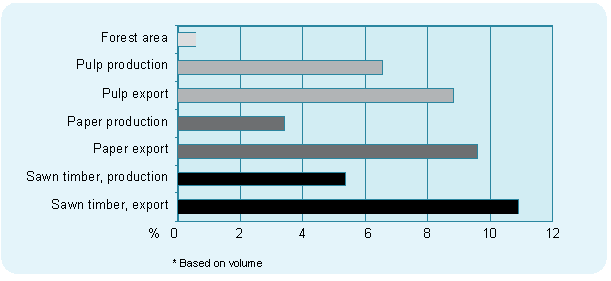
As shown in the following figure, Sweden occupied second place, when pulp, paper and sawn wood production are totalled, and third place for sawn timber.
Figure 21. Forest products production
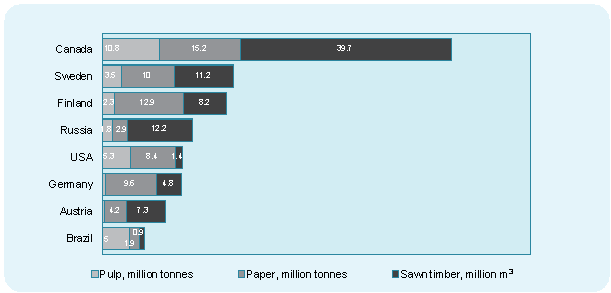
This kind of industry provides indirect employment, such as local services, schools and other activities related with this sector. It is necessary to call for a political message regarding capital investments. Sustainability is one of the most important issues in the agenda of the forest industry, both at company and association level. It is therefore very important to consider the forest products industry as a driving partner in a large cluster
The chart below shows not only the many different aspects and the interrelationships in the forest industry, but also gives an overview of all different sectors that are engaged by the forest industry as suppliers and as clients. There are some calculations of the affect on employment at the supplier’s level.
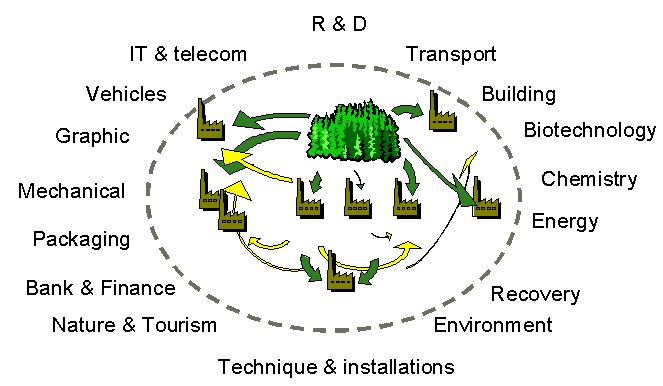
The work and achievements are documented in companys’ reports. Many Swedish companies are world leaders in sustainable development measures. In 2003, CEPI was the first European industry sector entity to launch a report called “The European paper industry on the road to sustainable development”, which has been updated in “CEPI sustainability report 2005”. CEI-Bois, the European woodworking organisation, launched fact sheets and a book called “Tackle climate change: use wood”, which has attracted a lot of attention. Last year, the Swedish Forest Industry Federation issued “The role of the Swedish forest industry in sustainable development”.
It is important to give policy makers and other stakeholders an overview of the sustainable work that is continuously on-going in the industry. The interpretation of sustainability should be understood in three dimensions: Environmental, Economic and Social level.
The amount of employment generated by the forest products industry shows a downward trend in Sweden, as in all so-called industrialised countries. Employment in service sectors is linked to the forest industry, which balances the reduction in the direct industry employment. It shows the industry’s “outsourcing” trend and concentration of core activities.
The chart shows how the 45 000 people directly employed in the pulp, paper and sawmilling industry generate employment for a total of 85 000 in those sectors that deliver goods and services to the industry. This gives a total of 130 000. It is interesting to note that a large part of the indirectly employed belong to different service sectors.
Figure 22. Employment generated at suppliers, pulp, paper and
sawmilling industry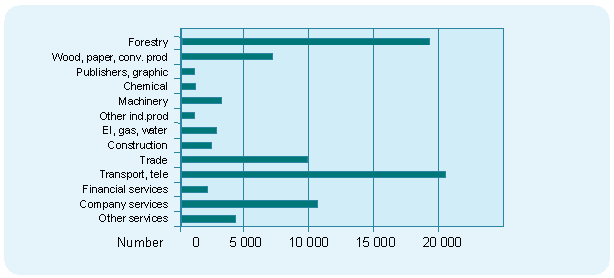
Sustainability is the way forward for the forest industry and its products, and constitutes the foundation for its operations. The products are made of renewable raw material, in environmentally adapted processes and are also recoverable. Forest, processes and products are part of a sustainable cycle; wood raw material from sustainably managed forests, preserving biodiversity of the forest landscape.
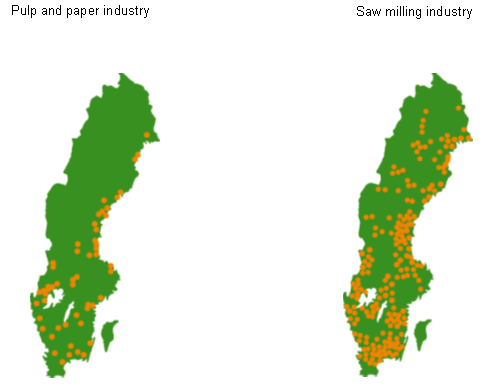
Figure 23. Exports and imports of some product groups 2005
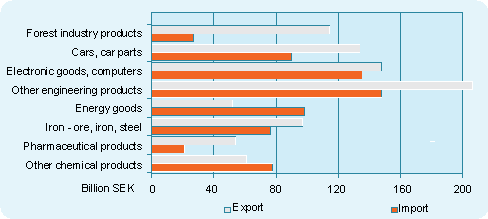
International trade in forest products generates a large export surplus for Sweden. In 2005, forest products worth 12,3 billion euro were exported, while imports of forestry products amounted to 2, 7 billion euro. This gives a surplus on the trade in forest products of 9,6 billion euro.
To be able to export forest products to the value of 12,3 billion euro, the forest industry must import input materials – wood, chemicals, oil etc – worth about 2,8 billion euro. Net exports, defined as exports of forestry products less imported input materials, thus amounted to some 9,5 billion euro.
Figure 24. Investment in the forest industries plants in Sweden
1980 – 2006
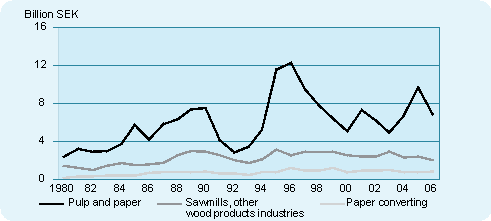
The investments amounted to an annual average of 1 billion euro in the forest industry during the last ten years. Investments in their turn create a large number of jobs in the supplier chain and further down to their suppliers. The large investments in 2005 in the pulp and paper industry are estimated to have generated more than 7 000 jobs with suppliers and their suppliers in turn. Some key figures are:
• Significant for regional development and employment
• In countries facing depopulation and unemployment the forest industry is a leading sector
• 20-35% of directly employed in the country’s total industry
• 20-50% of the production value in the country’s total industry
• 20-50% of the value added in the county’s total industry
Figure 25. Jobs generated by Stora Enso pulp, paper and sawmilling
industry in Sweden
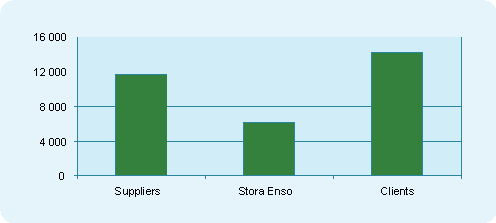
As an example, Stora Enso has over 6 000 people employed in their pulp, paper and sawn timber mills in Sweden. They generate some 12 000 jobs with suppliers, and some 14 000 jobs with clients in the packaging, printing and wood mechanical industries and other converters.
Note: the methodology is not the same for the calculations of Holmen and Stora Enso.
Some sawmills are carrying out important restructuring phases to secure necessary investments, demanding more competence development, and running joint projects to reduce accidents as well as develop new statistical systems and industry agreements.
In 1995 an “industry agreement” was set up to secure dialogue on competitiveness, both during and between labour negotiations. This involves representation of chairmen of employers’ federation and unions as well as working groups on working conditions, energy, research and development and competitiveness.
Below are some examples of companys’ enrolment in the local and county community activities:
• Shareholders and Board members in local development companies, ports, research councils at universities and research institutes
• Seats at local and regional Chambers of Commerce
• Property owners and landlords
• Humane sponsoring: SOS Children’s Villages, Médicins Sans Frontières, Swedish Brain Foundation
• Cultural sponsoring: Symphony orchestras, theatres
• Sport sponsoring: football and hockey clubs, individual athletes.
Sweden grows with its forests.
Mike Edwards, Director of Forestry South Africa, presented the case of his country.
The forestry sector plays an important role in the formal and informal economy. While maintaining a relatively high economic growth, the country is facing a number of challenges, including its high unemployment rate.
South Africa is a developing status country. Due to previous governments, in its policies there are serious disparities between the “haves” and the “have nots” (i.e. 1st and 2nd or formal and informal economies). This country has a worrying unemployment situation. To address the economic disparities and unemployment, sustained accelerated GDP. growth is imperative.
Table 10. South Africa Socio-economics Situation
Current Population Population Growth 1985 to 2005 Population Growth (to 2020) Population under age of 14 years 90.7% ex previously disadvantaged Group Population infected with HIV/AIDS % of population between ages of 15 &49 who are HIV/AIDS infected Increasing population drift fromrural to urban environment |
46,9 million 1,7% p.a. 1,0% p.a. 35,0% of total 42,5 million 5 million 20,0% 1% p.a |
On an expanded basis, the current unemployment rate is 41 percent of the economically active population (20 million) or 8.2 million. Between 1996 and 2005 the EAP. grew by 41 percent, but the number of people employed only rose by 28 percent, so unemployment increased by 31 percent. Growth in “discouraged” workseekers increased by 127 percent between 1995 and 2005. Growth in number of people living on less than US$1.00/day between 1995 and 2005 was also 127 percent.
• Maintain a consistently high economic growth rate (current rate ± 4 percent p.a.: need minimum 6 percent);
• Transform Economy to integrate and absorb people from previously disadvantaged sectors;
• Huge push to develop skills levels;
• Need to address HIV/AIDS pandemic;
• Need to boost rural economic development to discourage urban migration/rural depopulation;
• Poverty alleviation crucial.
Table 11. Forest Sector Unemployed
Sub-sector |
No. of employees |
Total Employment |
|
Direct |
Indirect |
||
Forestry |
76 844 |
30 000 |
106 844 |
Pulp and Paper |
13 200 |
10 781 |
23 981 |
Sawmilling |
20 000 |
n/a |
20 000 |
Timber Board |
6 000 |
n/a |
6 000 |
Mining Timber |
2 200 |
n/a |
2 200 |
Other |
11 000 |
n/a |
11 000 |
TOTAL |
129 244 |
40 781 |
170 025 |
Table 12. Income Generation in Sector
|
Sub-Sector |
Rem/Employee p.a. |
No. Employed |
Annual Income |
|
|
Forestry |
R13 600 |
106 844 |
R1,4 billion |
|
|
Forest Products |
R50 648 |
63 181 |
R3,2 billion |
|
|
Av. Remuneration in Agric Sector |
R10 910/p.a. |
|||
|
Av. Remuneration in Manuf. Sector |
R48 669/p.a. |
|||
Both forestry and forest products have higher values than sector average.
Employment and livelihood support:
• Both forestry and forest products activity is rurally based;
• Average size of rural household is 6 people.
Forest sector provides livelihood support to 850 000 people or a means of survival to almost five percent of South Africa rural population.
Table 13. Non-cash benefits of forestry employment
Benefits |
Current Status |
Cost p.a. to employer |
Housing |
65 percent of all employees (direct) provided with housing at no cost water & Electrical reticulation included. |
± R50 mill. |
Health Care |
- 90 percent of Forestry Co’s maintain clinics with Qualified staff, open to employees, dependents and communities. Courses in HIV/AIDS prevention & care, family planning, primary health care and first aid provided |
± R10 mill. |
Retirement funding |
- All employees covered (i.e. Pension/Provident Schemes). All employees covered by unemployment insurance. |
± R60 mill. |
Education |
± 15 000 children go to company run primary schools. Schools open to communities. Where no schools transport provided |
± R10 mill. |
Food/Rations |
- Provided where applicable |
± R20 mill. |
Other |
Protective clothing Recreational facilities Subsistence Farming Land |
± R10 mill. |
TOTAL |
|
± R160 mill. |
(N.B. Industry investment in abovementioned ± r 700 million)
Industry sponsored emerging grower
Grower initiative
• Currently industry supports and promotes over 20 000 emerging timber growers;
• Support given relates to interest free establishment and maintenance loans, provision of improved seedlings, transfer of technical skills, extension and guaranteed markets;
• Industry investment in the schemes amounts to over R200 million;
• Annual revenues generated currently ± R180 million;
• The existing 40 000 ha’s planted on these schemes is likely to increase by 100 000 ha’s over the next 25 yrs;
• Approximately 20 000 people are employed (excl. owners).
Operations
• Over the last 20 years there has been a major shift toward outsourcing of forestry operations;
• Currently 60 – 70 percent of all production is done by contractors;
• Many S.M.M.E. opportunities have been created through outsourcing with over 200 contracting firms employing 30 000 + people now in operation;
• Many problems exist however. Those amongst the more important being:
– Lack of business skills.
– Lack of professionalism
– Lack of capital resources.
– Short duration of contracts.
– Non-compliance with legislation.
– Poor relationships with forestry companies.
Future employment opportunities
• Assuming new afforestation rate of 100 000 ha’s:
Table 14. Employment
Additional Employment |
|
|
Forestry Sector |
Products sector |
|
41 250 |
1 900 |
|
VALUE ADDITION |
|
|
Forestry Sector |
Products sector |
|
R500 million |
R630 million |
•The forest sector creates huge employment opportunities in rural areas.
•It has a major role to play in alleviating poverty in rural areas
•Income generated significantly boosts local economic development, leading to further employment creation.
•The industry alleviates government responsibility in providing social infrastructure and generates an increased tax base.
•Emerging grower development initiatives and outsourcing create important opportunities for entrepreneurial advancement and will help to break cycle of social dependency.
•Growth and sustainability of industry will assist in stemming urban migration and will assist integration of 1st and 2nd economies.
•Industry based HIV/AID’s interventions will assist government. in addressing pandemic.
Ms Sheam Satkuru-Granzella, senior executive of the Malaysian timber Council, London, presented a brief update on the Malaysian timber industry.
Malaysia has a population of 25 million people with the total population having almost doubled in the last 20 years. The country therefore enjoys a young population and is not faced with ageism, a phenomenon facing several developed economies around the world.
Economic growth for the country is expected to remain stable averaging 6 – 7% per year for the next two years.
Malaysia further enjoys a sound and established judiciary and financial structures supported by political stability. Malaysia is currently moving towards an Industrialised Nation status, to be achieved by 2020. Nevertheless, the Malaysian government is committed to maintaining at least 50 percent of its forest areas in perpetuity.
Table 15. Forest land use Malaysia
Forest Land Use Malaysia 2004 |
Million ha |
Permanent Reserved Forest 73.7% Production (SFM) Totally Protected |
14.39 (11.18) ( 3.21) |
State Land/Alienated Land 15.3% |
2.98 |
National Parks/Wildlife & Bird Sanctuaries
11% |
2.15 |
TOTAL FOREST AREA 100% |
19.52 |
• Exports earning: RM 21.45 billion (2005) equivalent US$6 billion, the main contributors for this are logs and sawn timber, plywood, veneer and furniture.
• In 2004, the forestry sector, together with the fishing, and livestock sectors contributed about 8.3 percent to the GDP and provided employment to about 300 000 people
• Growth focused on downstream value-added sector
Table 16. Total Forest & Tree Cover
Total Forest & Tree Cover In Malaysia 2004 (Million ha) |
||
Types |
Million Ha |
% Malaysia |
Forest Oil Palm Rubber Cocoa & Coconut |
19.52 3.37 1.43 0.72 |
59.5 10.3 4.3 2.2 |
TOTAL FOREST & TREE COVER |
25.04 |
76.3 |
Other Land Use |
7.79 |
23.7 |
TOTAL LAND AREA |
32.83 |
100 |
IMF is helping through financial assistance; that is, the Malaysia National Economic Plan.
Malaysia’s Timber Production in 2004
• Logs: 20.4 million m³
• Sawn timber: 5.0 million m³
• Plywood: 4.7 million m³
• Veneer: 0.6 million m³
• Moulding: 0.4 million m³
Malaysia is the largest supplier of tropical timber and wood products to the EU markets (Germany, Netherlands, the U.K., and to a lesser extent France, Italy, Belgium). Probably in the future, the products will go to Poland, Rumanian, Ukrainian and Russia markets.
Main challenges
Allegations of Illegal Logging & Associated Trade.
Illegal logging is not a problem in Malaysia. A study funded by the American Forest and Paper Association in November 2004 stated that NGO allegations of illegal domestic forest activity in Malaysia are likely overstated since regulations for timber operators and companies appear to be well-enforced.
According to a report prepared and published by the World Bank and WWF Malaysia in 2001, illegal felling amounts to less than one percent of the timber harvested in Malaysia, both in Peninsular Malaysia and in the two states on the island of Borneo, Sabah and Sarawak. For about a decade, Malaysia has been working hard to put an end to illegal felling and to a very large extent this work has been successful.
Allegations of Associated Trade in Illegally Sourced Timber
Measures taken include:
• The imposition of reciprocal import bans by the Malaysian government for round logs and square logs from Indonesia in 2002 & 2003;
• The involvement of the Malaysian government and related authorities in ongoing efforts with the Indonesian government to address problems of cross-border smuggling from Indonesia into Malaysia;
• The strengthened enforcement by Malaysian agencies and port authorities in attempts to reduce and overcome smuggling of Indonesian timber into Malaysia;
• The involvement of Malaysian agencies in regional and international efforts to address issues related to document falsification/transhipment in international waters by non-Malaysian organizations in attempts to pass-off Indonesian timber as Malaysian timber in order to avoid scrutiny from international ENGOs and responsible traders.
Forest & Timber Certification
Malaysian Timber Certification Council (established 1999, operational 2000) - www.mtcc.com.my
The latest Malaysian Criteria & Indicators (2002) are being implemented as of 1st January 2006, incorporating elements of:
• Resource security
• Sustainable harvest
• Implementation of reduced / low impact logging
• Protection of endangered, rare & threatened species
• Recognition of tenure and user rights over the forest
• Aspects covering economic, social and cultural requirements for good forest management.
Recognition of MTCC certification
Government of Denmark has included the MTCC scheme as one of the accepted schemes in its document entitled ‘Purchasing Tropical Timber - Environmental Guidelines’ (October 2003).
UK’s Government’s Central Point of Expertise on Timber (CPET) has also concluded that MTCC scheme provides assurance of legally harvested timber (November 2004).
Government of France has included the MTCC scheme as one of schemes acceptable under its public procurement policy.
Seven certified FMUs and 26 holders of MTCC Certificate for Chain-of-Custody (CoC) accepted under Keurhout Protocol for legal origin (in The Netherlands) (September 2005). By March 2006, 24 holders of CoC accepted, likely to increase in the near future.
On going efforts with the Government of Belgium on the future recognition of the MTCC scheme.
Progress very often hampered by ENGO campaigns incorporating unsubstantiated allegations against the operations of the scheme. Counter-measure: Active communications efforts by both MTC & MTCC in asserting and highlighting MTCC’s progress and achievements, engaging in dialogue with all stakeholders in attempts to address concerns.
• Ensuring availability of sufficient raw materials to meet industry needs by sourcing timber from external legal sources, developing tree plantations and promoting more efficient use of existing resources;
• Actively promoting the use of lesser-known species as alternatives to several applications and reduce pressure on traditional species;
• The establishment of fast-growing plantation timber species to meet the needs of select industry sectors in order to reduce pressure on natural forests. BUT this is NOT done at the expense of natural forests. All plantation establishments are planned in line with the country’s national economic and development plans;
• Meeting the demands of growing overseas markets which remain strong, resulting in increasing demand for Malaysian timber products and firming of prices. However, the Malaysian timber industry is fully aware of the need to remain competitive in the international market owing to cheaper production by other producing countries.
• The establishment of green procurement policies by international timber industries and government bodies focusing on legality and sustainability;
• Continuing focus on forest and timber certification, with special emphasis on indigenous peoples;
• The active involvement of Malaysia in the EU FLEGT Action Plan and Associated Voluntary Partnership Agreements/EU Timber Trade Action Plan Project. EU wants to formalize the polices in September. Active involved, illegal logging is lesser than 1%, estimated of lesser than 10 percent, black market, Indonesian government;
• Measures to balance the ongoing anti-tropical timber perception within certain sectors.
• To rigorously promote further recognition and acceptance of the MTCC certification scheme in Europe;
• To continue focusing on value-adding in order to further develop the Malaysian timber industry, to better utilise raw materials and consolidate energy consumption;
• To continue toe encourage integrated production chains in Malaysia where feasible;
• To focus on niche markets for better quality product sectors.
Mr Hervé Bourguignon, Secretary-General of the Inter-African Forest Industries Association (IFIA) gave a brief description of the socio-economic importance of the African tropical industry.
IFIA brings together different timber and forest industry associations of the Congo Basin and West African regions. There is a very diverse situation in the different African countries. In West Africa more degraded forest can be found than in the other African regions, very often penetrated by villagers’ agricultural activities. In the Congo Basin Region there is mainly dense tropical forest. For example, Gabon with about 1.5 million inhabitants has an extension of 250 000 km2, 90% covered with forest; DRC, has 55 million inhabitants and a vast part of the territory is covered by forest.
The economic and social contribution of the forestry sector in this region plays an important role. In some countries it accounts for between 7 and 12 percent of the total GNP. In Gabon, mining and petrol cover 60 percent of the GNP. In the Central African Republic, half the exports are wood. In terms of employment, there are about 1 000 companies in the forestry sector in the Congo Basin region. About 300 have a formal structure; no more than 50 have mid- to long- term vision of how to work towards sustainable development. This industry represents roughly 30 000 persons directly employed. If subcontractors are considered, this number could be as much as one million employees and, including their family members, could account for 10 million people in the Congo Basin Region. Many forestry activities are carried out in line with sustainable development, but illegal logging and illegal trade constitute serious threats to the forest, to responsible industry and to society in general. In the Congo Basin Region there are 53 million ha of forest allocated as concessions, 20 million ha of this area is managed according to forest management plans and 10 million ha are today validated through local administrations.
Some small companies have reached a certain level in managing their forest concessions sustainably, but due to lack of resources there are difficulties in further improving their operations.
A major obstacle for development in Africa remains the low level of investment. Less than one percent of global investment comes to Africa, taking into account Nigeria and South Africa. There are many reasons for not encouraging investments in the forestry sector. Some of these are related to political instability, poor governance and illegal forestry activities. IFIA supports efforts to combat illegal logging and illegal trade of forest products.
Another reason for low investment relates to the taxation systems for forest concessions. It should be recognized that forest concessions are often a source for development in rural areas. Concessionaires often take care of their workers, provide education and health care. Tax systems should take into account this additional cost on infrastructure, which should be normally provided by local governments. The main challenge in Africa is to create a business friendly environment in order to promote investor confidence.
Mr Adrian Whitemann, FAO Senior Forestry Officer presented some of the challenges faced in the collection of reliable data on the socio-economic contribution of forestry. He explained what FAO is doing about income and employment generated by the forestry sector and why the perceived importance of the sector is under-valued.
At various FAO forestry meetings in recent years, many countries have commented that policy makers do not recognise or understand the important contributions that the forestry sector makes to income, employment and economic development. In response to these concerns, FAO has started to collect information about the contribution of the sector to national income (value-added), employment and trade. The most recent output of this effort is the publication: Trends and current status of the contribution of the forestry sector to national economies (Lebedys, 2004). In addition to this study, FAO has also been working on small-scale case-studies about the contribution of the sector to economic development. These studies have mostly examined developments at the local level and with respect to informal activities, such as the collection of woodfuel and non-wood forest products.
This work has revealed a number of problems and challenges in the following areas:
•unclear definitions and methodologies (e.g. what should be included in the "forestry sector");
•discrepancies in national statistics on employment and value-added (e.g. Canada: 4 different estimates of employment; UK: 2 different estimates of value-added in forestry, etc.);
•the question of "are national statistics useful?" (e.g. at the national level, the contribution of the sector is generally small in almost all countries, but it can be very important in specific regions or localities); and
•the question of "what is the measure of success?" (e.g. falling employment numbers may suggest that the sector is making less of a contribution, but this may be a result of increasing labour productivity, which is a good thing and can be associated with higher wage rates, higher skill levels in the sector and fewer industrial accidents and injuries).
Considering the above, FAO seeks guidance from members of the ACPWP on the following questions:
How can we make this work more useful and relevant?
•more work on methodologies and basic data collection;
•more work on policy appraisal and analysis;
•more focus on specific sectors or regions;
•studies of other variables showing the contribution of the sector;
•more case studies (e.g. examples of success in specific industries and/or locations); or
•no change to the current approach?
How can we improve the way we implement this work (modalities)?
•who is the audience for these studies?;
•is there any potential for support and collaboration?; and
•what can be done to improve dissemination and result in a bigger impact?
FAO invites participants of the ACPWP to provide comments and guidance in response to these questions.